|
< Previous family introduction |
|
|||||
 |
Family Haminoeidae Haminoeid bubble shells
|
|||||
|
The species of Haminoeidae are some of the few plentiful and predictably abundant sea slugs in tropical and temperate seas. They occur on reefs and on mud and sand flats, around all of the Australian coastline. There are several hundred species worldwide, distributed among about 15 genera. In this family the shells are always external, and lightly or moderately calcified. They vary in form from elongate with a narrow aperture, as in Cylichnatys, to globose with a wider aperture, as in Haminoea. The inner whorls are resorbed, allowing more space for the animal, which can fully retract into its shell. Haminoeids have both a radula and gizzard plates to masticate their food. Species live intertidally and in the shallow subtidal. They are herbivorous, grazing on green algae, and are most commonly infaunally with a few being epifaunal. The infaunal species burrow through the top layer of fine sediment and are usually drab in colour, while the epifaunal species craw upon their host alga, and are often brightly coloured. Family Reference Burn (2015) described and illustrated the Victorian species and some of the NSW species. Coverage In addition to the species treated in detail, the following are recorded from NSW: Ventomnestia colorata Iredale, 1936.
Atys naucum (Linnaeus, 1758)
The following were reported as living in NSW by Nimbs & Smith (2017):
Identification Notes Some haminoeid shells are elongate, thus impossible to distinguish solely on shell characters from those of the Cylichnidae. More often, as in Haminoea, the shells are globose, with a fairly wide aperture.
|